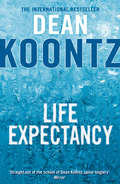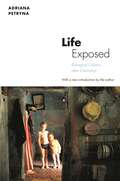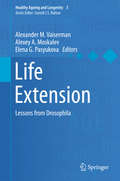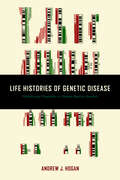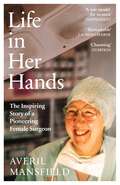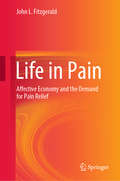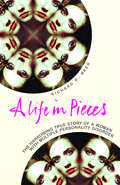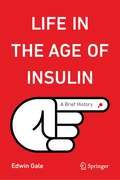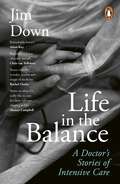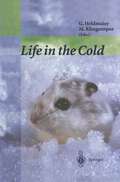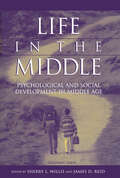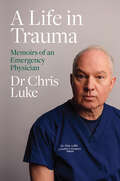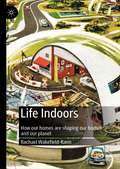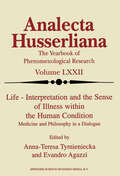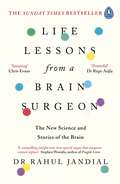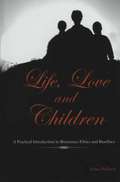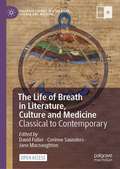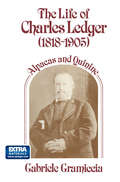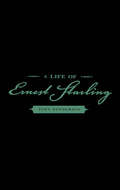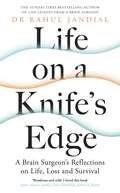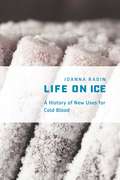- Table View
- List View
Life Expectancy
by Dean KoontzIn the dazzling new thriller from the master of dark suspense, the hand of fate reaches out to touch an ordinary man with greatness. So long as he is ready. So long as he is, above all, afraid.
Life Exposed: Biological Citizens after Chernobyl
by Adriana PetrynaOn April 26, 1986, Unit Four of the Chernobyl nuclear reactor exploded in then Soviet Ukraine. More than 3.5 million people in Ukraine alone, not to mention many citizens of surrounding countries, are still suffering the effects. Life Exposed is the first book to comprehensively examine the vexed political, scientific, and social circumstances that followed the disaster. Tracing the story from an initial lack of disclosure to post-Soviet democratizing attempts to compensate sufferers, Adriana Petryna uses anthropological tools to take us into a world whose social realities are far more immediate and stark than those described by policymakers and scientists. She asks: What happens to politics when state officials fail to inform their fellow citizens of real threats to life? What are the moral and political consequences of remedies available in the wake of technological disasters? Through extensive research in state institutions, clinics, laboratories, and with affected families and workers of the so-called Zone, Petryna illustrates how the event and its aftermath have not only shaped the course of an independent nation but have made health a negotiated realm of entitlement. She tracks the emergence of a "biological citizenship" in which assaults on health become the coinage through which sufferers stake claims for biomedical resources, social equity, and human rights. Life Exposed provides an anthropological framework for understanding the politics of emergent democracies, the nature of citizenship claims, and everyday forms of survival as they are interwoven with the profound changes that accompanied the collapse of the Soviet Union.
Life Exposed: Biological Citizens after Chernobyl
by Adriana PetrynaOn April 26, 1986, Unit Four of the Chernobyl nuclear reactor exploded in then Soviet Ukraine. More than 3.5 million people in Ukraine alone, not to mention many citizens of surrounding countries, are still suffering the effects. Life Exposed is the first book to comprehensively examine the vexed political, scientific, and social circumstances that followed the disaster. Tracing the story from an initial lack of disclosure to post-Soviet democratizing attempts to compensate sufferers, Adriana Petryna uses anthropological tools to take us into a world whose social realities are far more immediate and stark than those described by policymakers and scientists. She asks: What happens to politics when state officials fail to inform their fellow citizens of real threats to life? What are the moral and political consequences of remedies available in the wake of technological disasters? Through extensive research in state institutions, clinics, laboratories, and with affected families and workers of the so-called Zone, Petryna illustrates how the event and its aftermath have not only shaped the course of an independent nation but have made health a negotiated realm of entitlement. She tracks the emergence of a "biological citizenship" in which assaults on health become the coinage through which sufferers stake claims for biomedical resources, social equity, and human rights. Life Exposed provides an anthropological framework for understanding the politics of emergent democracies, the nature of citizenship claims, and everyday forms of survival as they are interwoven with the profound changes that accompanied the collapse of the Soviet Union.
Life Extension: Lessons from Drosophila (Healthy Ageing and Longevity #3)
by Alexander M. Vaiserman Alexey A. Moskalev Elena G. PasyukovaThis book looks at aging through research on Drosophila, the fruit fly that is one of the most widely used model organisms in bio gerontology. Work in model organisms can expand the theoretical knowledge of aging: it yields valuable insight into the molecular and cellular processes that underlie aging process, and it can perhaps provide new therapeutic targets for the treatment of age-related disorders in humans.Drosophila models have been developed for a large variety of aging-related processes and diseases, and this book provides readers with an overview of current research on the use of the Drosophila model to understand the genetic, molecular and physiological mechanisms that underlie the aging process. Themes of health span, life extension and longevity-associated genes emerge in this collation of international research on Drosophila that is of relevance to geriatrics and gerontology, animal genetics and genomics, and biomedicine.This fascinating, illustrated book will be of interest to a wide audience, ranging from academic researchers to the general reader.
Life Histories of Genetic Disease: Patterns and Prevention in Postwar Medical Genetics
by Andrew J. HoganMedical geneticists began mapping the chromosomal infrastructure piece by piece in the 1970s by focusing on what was known about individual genetic disorders. Five decades later, their infrastructure had become an edifice for prevention, allowing today;€™s expecting parents to choose to test prenatally for hundreds of disease-specific mutations using powerful genetic testing platforms. In Life Histories of Genetic Disease, Andrew J. Hogan explores how various diseases were "made genetic" after 1960, with the long-term aim of treating and curing them using gene therapy. In the process, he explains, these disorders were located in the human genome and became targets for prenatal prevention, while the ongoing promise of gene therapy remained on the distant horizon.In narrating the history of research that contributed to diagnostic genetic medicine, Hogan describes the expanding scope of prenatal diagnosis and prevention. He draws on case studies of Prader-Willi, fragile X, DiGeorge, and velo-cardio-facial syndromes to illustrate that almost all testing in medical genetics is inseparable from the larger;¢;‚¬;€?and increasingly "big data";€“oriented;¢;‚¬;€?aims of biomedical research. Hogan also reveals how contemporary genetic testing infrastructure reflects an intense collaboration among cytogeneticists, molecular biologists, and doctors specializing in human malformation.Hogan critiques the modern ideology of genetic prevention, which suggests that all pregnancies are at risk for genetic disease and should be subject to extensive genomic screening. He examines the dilemmas and ethics of the use of prenatal diagnostic information in an era when medical geneticists and biotechnology companies have begun offering whole genome prenatal screening;¢;‚¬;€?essentially searching for any disease-causing mutation. Hogan;€™s focus and analysis is animated by ongoing scientific and scholarly debates about the extent to which the preventive focus in contemporary medical genetics resembles the aims of earlier eugenicists. Written for historians, sociologists, and anthropologists of science and medicine, as well as bioethics scholars, physicians, geneticists, and families affected by genetic conditions, Life Histories of Genetic Disease is a profound exploration of the scientific culture surrounding malformation and mutation.
Life Histories of Genetic Disease: Patterns and Prevention in Postwar Medical Genetics
by Andrew J. HoganMedical geneticists began mapping the chromosomal infrastructure piece by piece in the 1970s by focusing on what was known about individual genetic disorders. Five decades later, their infrastructure had become an edifice for prevention, allowing today;€™s expecting parents to choose to test prenatally for hundreds of disease-specific mutations using powerful genetic testing platforms. In Life Histories of Genetic Disease, Andrew J. Hogan explores how various diseases were "made genetic" after 1960, with the long-term aim of treating and curing them using gene therapy. In the process, he explains, these disorders were located in the human genome and became targets for prenatal prevention, while the ongoing promise of gene therapy remained on the distant horizon.In narrating the history of research that contributed to diagnostic genetic medicine, Hogan describes the expanding scope of prenatal diagnosis and prevention. He draws on case studies of Prader-Willi, fragile X, DiGeorge, and velo-cardio-facial syndromes to illustrate that almost all testing in medical genetics is inseparable from the larger;¢;‚¬;€?and increasingly "big data";€“oriented;¢;‚¬;€?aims of biomedical research. Hogan also reveals how contemporary genetic testing infrastructure reflects an intense collaboration among cytogeneticists, molecular biologists, and doctors specializing in human malformation.Hogan critiques the modern ideology of genetic prevention, which suggests that all pregnancies are at risk for genetic disease and should be subject to extensive genomic screening. He examines the dilemmas and ethics of the use of prenatal diagnostic information in an era when medical geneticists and biotechnology companies have begun offering whole genome prenatal screening;¢;‚¬;€?essentially searching for any disease-causing mutation. Hogan;€™s focus and analysis is animated by ongoing scientific and scholarly debates about the extent to which the preventive focus in contemporary medical genetics resembles the aims of earlier eugenicists. Written for historians, sociologists, and anthropologists of science and medicine, as well as bioethics scholars, physicians, geneticists, and families affected by genetic conditions, Life Histories of Genetic Disease is a profound exploration of the scientific culture surrounding malformation and mutation.
Life in Her Hands: The Inspiring Story of a Pioneering Female Surgeon
by Averil Mansfield'A great read. I am honoured to have worked with such a legend' David Nott'A role model for women' Independent'A wonderful read' Julian Fellowes'Remarkable' Lauren Laverne'Charming' GuardianWe were occasionally expected to travel by ambulance to a serious case and would always have a kit of tools and drugs ready for emergency calls. On one occasion, we were responding to a man who had fallen into the hold of a grain ship and broken his leg. I was expected to go down a pole into the ship to administer analgaesia before he could be rescued. The 'audience' of shipworkers delighted in telling me that there were rats the size of dogs down in the grain. The other problem was that this was the era of the mini skirt, and you can imagine what that meant. Following the incident, I instituted the purchase of some 'Casualty Officers Emergency Dungarees' as an addition to the kit.Averil Mansfield established herself as a pioneer in every sense of the word when she qualified as a surgeon in the early 1970s. At the time just two per cent of her colleagues were female, and she was often met with surprise, bordering on disbelief and amusement, when telling people what she did. But time and again, Averil proved herself more than capable of the role which had been her greatest dream since the age of eight. After a formidable operating career in Liverpool and London, during which she made many enduring friendships, she went on to became the UK's first ever female professor of surgery.Life in Her Hands is the remarkable story of a truly trailblazing woman. Averil's account shines light on a medical and societal world that has changed beyond measure, but which - as she shows through her experiences - still has a long way to go for the women finding their place within it.
Life in Pain: Affective Economy and the Demand for Pain Relief
by John L. FitzgeraldThis book explores pain in a number of ways. At the heart of the book is an extension of Melzack’s neuromatrix theory of pain into the social, cultural, and economic fields. Specific assemblages involving varied institutions, flows of capital, encounters, and social and economic structures provide a framework for the formation of pain, its perception, experience, meaning, and cultural production. Complementing the extended neuromatrix is a second theory, focussed on the propensity of western market capitalism to seek out new areas of life to subsume to capital. Pain is one such life area that is now ripe for exploitation. Although the book has theory at its heart, it draws extensively on case studies to identify the contradictions and complexities. Case studies are drawn from accounts of drug use in varied contexts such as prescription drugs, methamphetamine use, oxycodone use in North America, and the global rise of the medicinal cannabis marketplace.
A Life in Pieces: The harrowing story of a woman with 17 personalities
by Richard K. BaerIn 1989 a woman named Karen showed up at author and psychiatrist Richard Baer's practice, terribly frightened and at breaking point. She explained that her husband beat her, her mother stole from her; she was in tremendous physical pain and wanted to die. Within a few sessions she also revealed that her father and grandfather had raped and tortured her repeatedly over the course of her childhood, frequently in the company of other neighbourhood men. She was now married with two children, but often could not account for stretches of minutes, hours, sometimes even days.As Karen's story unfolded over the following months, Baer realised that he was dealing with a severe case of Multiple Personality Disorder. Although it would take time and deep, hard-won trust before any of Karen's alternated personalities presented themselves in her psychiatrist's office, over the next five years Baer would encounter seventeen distinct personalities, all of whom had been living inside Karen since she was a young child, shielding her from an otherwise unbearable life.In the tradition of Oliver Saks and Irvin Yalom, Baer chronicles his nine years of work with Karen and all her distinct personalities, his often futile efforts to use the tools of his trade, and his patient's ultimate invention of her own cure. An unforgettable story of unimaginable suffering and ultimate recovery, A Life In Pieces: How One Woman's Personality was Shattered by Years of Abuse is the first account of life with Multiple Personality Disorder written by the treating psychiatrist.
Life in the Age of Insulin: A Brief History (Copernicus Books)
by Edwin GaleLife in the Age of Insulin offers a straightforward and jargon-free narrative account of how insulin was discovered, what it does, why people still struggle to obtain it, and what the future might hold. It tells of the creative power that emerges when many people work towards a common goal, and of collective strength founded upon the limitations of individuals. It envisages a future of competitive insulin pricing and revolutionary therapies, kindling hope for health equity. With over 70 million insulin users world-wide, this book bridges the gap for patients and families. It will appeal to health professionals, to those intrigued by science, and to anyone who likes a good story. Life in the Age of Insulin is an empathetic and enlightening saga of science, society and human resilience.
Life in the Balance: A Doctor’s Stories of Intensive Care
by Dr Jim Down'A remarkably honest memoir of a life spent pulling people back from death' - Adam KayIn these stories, Dr Jim Down brings us to the very heart of the intensive care unit - the section of the hospital where the sickest patients are brought to be cared for until their condition improves. With honesty, humility and a streak of dark humour, Dr Down describes the quietly heroic work of doctors and nurses on the ICU, a place which sits at the cutting edge of medical technology and where a split-second decision can make the difference between life and death.From headline-grabbing cases like that of Alexander Litvinenko, poisoned by Russian agents and admitted to Down's ward, to the appalling aftermath of a train crash, Life in the Balance offers an inside glimpse of intensive care medicine, its immense challenges, deleterious effects on doctors' mental health and enormous rewards. Its profundity will make you reconsider the fragility of life and reframe your understanding of what it means to care.
Life in the Cold: Eleventh International Hibernation Symposium
by Gerhard Heldmaier Martin F. Bach Susanne KlausThis book contains the proceedings of the 11 'h international symposium dedicated to the understanding of animal "Life in the Cold", held at Jungholz (Austria), August 13-18, 2000. In 55 chapters contributed by researchers from 16 countries the current state of knowledge is reviewed, and the most recent developments and discussions in this field are highlighted. The first symposium on hibernation and life in the cold was held in 1959, and from then on they continued to occur every 3-5 years. The regular occurrence of these meetings became almost a tradition. A tradition which is entirely based on the enthusiasm of participants, and was nourished by scientific progress in this area during the past decades. The first symposium in 1959 was organised by Charles P. Lyman and Albert R. Dawe and was almost entirely dedicated to hibernation and torpor. This has been a backbone topic of the following symposia, although other aspects of animal energetics, thermal physiology and biochemistry were included in later meetings.
Life in the Middle: Psychological and Social Development in Middle Age
by Sherry L. Willis James B. ReidThere is a growing body of scientific knowledge regarding development during the middle years which has so far been relegated to discipline-specific texts and journals (e.g., clinical psychology and endocrinology). Life in the Middle consolidates main findings across disciplines, with a life-span perspective regarding mid-life. Coverage includes individual development in middle age from the psychological and biological perspectives as well as the sociocultural context in which middle-aged individuals live and work, including physical health in mid-life, psychological well-being, cognitive development, the impact of work on the individual, and the general development of the "self." This age period is increasingly becoming the focus of scholarly attention as the largest cohort in U.S. history are now moving into the middle years (e.g., the "babyboomers"). From 1990 to 2015 the number of middle-aged people will increase 72 percent from 47 to 80 million. Contributors are outstanding scholars in the field of adult development Addresses critical theoretical issues in midlife Includes important contributions to our understanding of physical health at midlife Presents a thorough review of women's health at midlife Takes a holistic approach to biopsychosocial functioning at midlife
A Life in Trauma: Memoirs of An Emergency Physician
by Chris LukeConcern. Compassion. Doubt. Despair. Anger. Hope. Imagine juggling these feelings every day in a situation where your work could mean the difference between someone’s life or death.For Dr Chris Luke, a consultant in emergency medicine, these emotions are an intrinsic part of the job – ranging from rage at a system that often leaves vulnerable people waiting anxiously, to the incomparable satisfaction of relieving patients’ suffering and distress.This revealing memoir takes us on a rollercoaster journey from Chris’s days as an orphanage boy through to becoming one of the leading emergency physicians in the country.A Life in Trauma is a remarkable account of a career spent helping others, sometimes at a painful personal cost, and ultimately offers a positive perspective on the potential of Ireland’s healthcare system.
Life Indoors: How our homes are shaping our bodies and our planet
by Rachael Wakefield-RannIn this timely and expansive book, Wakefield-Rann investigates how emerging disease ecologies are undermining definitions of health and immunity that have persisted since the 19th century, and had a formative influence over the design of not only homes, but entire cities. This wide-ranging account traces the links between the history of medicine, modernist design and architecture, the rise of inflammatory disease, the microbiomes of buildings and humans, antimicrobial resistance, and novel chemical pollutants, to show how indoor environments have made us as we have made them. In highlighting the processes that have been missed in designing perfectly controlled interior habitats, Life Indoors shows the limitations of dominant practices, classifications and philosophies to apprehend current indoor pathogen ecologies.
Life Interpretation and the Sense of Illness within the Human Condition: Medicine and Philosophy in a Dialogue (Analecta Husserliana #72)
by Anna-Teresa Tymieniecka E. AgazziIn medicine the understanding and interpretation of the complex reality of illness currently refers either to an organismic approach that focuses on the physical or to a 'holistic' approach that takes into account the patient's human sociocultural involvement. Yet as the papers of this collection show, the suffering human person refers ultimately to his/her existential sphere. Hence, praxis is supplemented by still other perspectives for valuation and interpretation: ethical, spiritual, and religious. Can medicine ignore these considerations or push them to the side as being subjective and arbitrary? Phenomenology/philosophy-of-life recognizes all of the above approaches to be essential facets of the Human Condition (Tymieniecka). This approach holds that all the facets of the Human Condition have equal objectivity and legitimacy. It completes the accepted medical outlook and points the way toward a new `medical humanism'.
Life Lessons from a Brain Surgeon: The New Science and Stories of the Brain
by Dr Rahul JandialTHE SUNDAY TIMES BESTSELLER*As heard on Chris Evans' Virgin Radio*'You're amazing I could talk to you (Rahul) all day' Chris Evans'This is a gripping new book' The TimesWorld-leading neuroscientist and neurosurgeon Dr Rahul Jandial draws on his years of work with patients suffering from the most extreme cases of brain damage, disorders and illnesses to reveal what they can tell us about the science of the mind. From a languages teacher who has to choose whether to lose her ability to speak Spanish or English after brain surgery, to a former TV exec, now homeless, who discovers that his life-altering despondency is the result of a tumour, to a fainting teen who learns that deep breathing can mean the difference between life or death, these stories uncover the secret workings of the brain. Blending cutting-edge research and beautiful storytelling, Life Lessons from a Brain Surgeon is a vital resource on the best ways to boost your memory, control stress and emotions, minimize pain, unleash your creativity, raise smart kids and reduce the risk of Alzheimer's. This is a deeply practical and readable book, which will take you on an expedition through the anatomy of the most fascinating - and mysterious - of organs.Rahul's new book Life on a Knife's Edge is out now.
Life, Love and Children: A Practical Introduction to Bioscience Ethics and Bioethics
by Irina PollardDiscussion of bioscience ethics requires understanding of the science that underpins biological systems impinging on our lives. Unencumbered by the formal structure of ethics, bioethics presents a forum for discussion of practical matters of individual and collective concern. This comprehensive text is a guide to the essentials of bioscience ethics and an interface between applied science and applied bioethics. Early chapters embrace topics affecting human reproduction – substance abuse and parenthood, aging gametes and congenital malformations, child abuse and its biological consequences. Intermediate chapters deal with end-of-life care and euthanasia, human fertility, assisted reproductive technologies, genetic engineering, and cloning. Remaining chapters challenge human-dominated ecosystems. Population growth, economic activity, and warfare – with its environmental consequences – are reviewed. A background section describes the evolution of ethical consciousness, explores the future, and proposes that the reworking of ethical boundaries can enhance mature decision-making in harmony with changing technology.
The Life of Breath in Literature, Culture and Medicine: Classical to Contemporary (Palgrave Studies in Literature, Science and Medicine)
by David Fuller Corinne Saunders Jane MacnaughtonThis open access book studies breath and breathing in literature and culture and provides crucial insights into the history of medicine, health and the emotions, the foundations of beliefs concerning body, spirit and world, the connections between breath and creativity and the phenomenology of breath and breathlessness. Contributions span the classical, medieval, early modern, Romantic, Victorian, modern and contemporary periods, drawing on medical writings, philosophy, theology and the visual arts as well as on literary, historical and cultural studies. The collection illustrates the complex significance and symbolic power of breath and breathlessness across time: breath is written deeply into ideas of nature, spirituality, emotion, creativity and being, and is inextricable from notions of consciousness, spirit, inspiration, voice, feeling, freedom and movement. The volume also demonstrates the long-standing connections between breath and place, politics and aesthetics, illuminating both contrasts and continuities.
The Life of Charles Ledger (1818-1905): Alpacas and Quinine
by Gabriele GramicciaThis is the first comprehensive study of the life and works of Charles Ledger. Ledger's great contribution to the world was the identification and cultivation of the 'best' unhybridized cinchona seed, from which 90% of the world's quinine was eventually produced. But Charles Ledger didn't only 'give' the world quinine, he led an adventurous life: perhaps his greatest feat being an epic drive of alpacas. He travelled 2500 km from Peru and Bolivia through Argentina and across the Andes to Peru, and then sailed to New South Wales in an attempt to establish an alpaca wool industry there - the journey took 6 years. He died unrecognised by the scientific community and poor.
A Life of Ernest Starling (People and Ideas)
by John HendersonErnest Starling (1866-1927) was pre-eminent in the golden age of British Physiology. His name is usually associated with his "Law of the Heart,” but his discovery of secretin (the first hormone whose mode of action was explained) and his work on capillaries were more important contributions. He coined the word 'hormone' one hundred years ago. His analysis of capillary function demonstrated that equal and opposite forces move across the capillary wall--an outward (hydrostatic) force and an inward (osmotic) force derived from plasma proteins.
Life on a Knife’s Edge: A Brain Surgeon’s Reflections on Life, Loss and Survival
by Dr Rahul Jandial'Wonderous and wild. I loved this book' James Nestor, bestselling author of Breath 'Moving, raw and unflinching' Julia Samuel, bestselling author of This Too Shall Pass'Incredible storytelling' Dr Rangan Chatterjee, bestselling author of Feel Better in 5____________________________________________________________________________How do you carry on when things go deadly wrong?When Dr Rahul Jandial operated on Karina, an eleven-year-old girl whose spinal cord was splitting in two, he had to make an impossible decision. He followed his head over his gut and Karina was left permanently paralysed, altering both patient and surgeon's lives for ever. This decision would haunt Rahul for decades, a constant reminder of the fine line between saving and damaging a life.As one of the world's leading brain surgeons, Rahul is the last hope for patients with extreme forms of cancer. In treating them, he has observed humanity at its most raw and most robust. He has journeyed to unimaginable extremes with them, guiding them through the darkest moments of their lives.Life on a Knife's Edge is Rahul's beautifully written account of the resilience, courage and belief he has witnessed in his patients, and the lessons about human nature he has learned from them. It is about the impossible choices he has to make, and the fateful consequences he is forced to live with.From challenging the ethics of surgical practices, to helping a patient with locked-in syndrome communicate her dying wish to her family, Rahul shares his extraordinary experiences, revealing the depths of a surgeon's psyche that is continuously pushed to its limits.
Life on Ice: A History of New Uses for Cold Blood
by Joanna RadinAfter the atomic bombing at the end of World War II, anxieties about survival in the nuclear age led scientists to begin stockpiling and freezing hundreds of thousands of blood samples from indigenous communities around the world. These samples were believed to embody potentially invaluable biological information about genetic ancestry, evolution, microbes, and much more. Today, they persist in freezers as part of a global tissue-based infrastructure. In Life on Ice, Joanna Radin examines how and why these frozen blood samples shaped the practice known as biobanking. The Cold War projects Radin tracks were meant to form an enduring total archive of indigenous blood before it was altered by the polluting forces of modernity. Freezing allowed that blood to act as a time-traveling resource. Radin explores the unique cultural and technical circumstances that created and gave momentum to the phenomenon of life on ice and shows how these preserved blood samples served as the building blocks for biomedicine at the dawn of the genomic age. In an era of vigorous ethical, legal, and cultural debates about genetic privacy and identity, Life on Ice reveals the larger picture—how we got here and the promises and problems involved with finding new uses for cold human blood samples.
Life on Ice: A History of New Uses for Cold Blood
by Joanna RadinAfter the atomic bombing at the end of World War II, anxieties about survival in the nuclear age led scientists to begin stockpiling and freezing hundreds of thousands of blood samples from indigenous communities around the world. These samples were believed to embody potentially invaluable biological information about genetic ancestry, evolution, microbes, and much more. Today, they persist in freezers as part of a global tissue-based infrastructure. In Life on Ice, Joanna Radin examines how and why these frozen blood samples shaped the practice known as biobanking. The Cold War projects Radin tracks were meant to form an enduring total archive of indigenous blood before it was altered by the polluting forces of modernity. Freezing allowed that blood to act as a time-traveling resource. Radin explores the unique cultural and technical circumstances that created and gave momentum to the phenomenon of life on ice and shows how these preserved blood samples served as the building blocks for biomedicine at the dawn of the genomic age. In an era of vigorous ethical, legal, and cultural debates about genetic privacy and identity, Life on Ice reveals the larger picture—how we got here and the promises and problems involved with finding new uses for cold human blood samples.
Life on Ice: A History of New Uses for Cold Blood
by Joanna RadinAfter the atomic bombing at the end of World War II, anxieties about survival in the nuclear age led scientists to begin stockpiling and freezing hundreds of thousands of blood samples from indigenous communities around the world. These samples were believed to embody potentially invaluable biological information about genetic ancestry, evolution, microbes, and much more. Today, they persist in freezers as part of a global tissue-based infrastructure. In Life on Ice, Joanna Radin examines how and why these frozen blood samples shaped the practice known as biobanking. The Cold War projects Radin tracks were meant to form an enduring total archive of indigenous blood before it was altered by the polluting forces of modernity. Freezing allowed that blood to act as a time-traveling resource. Radin explores the unique cultural and technical circumstances that created and gave momentum to the phenomenon of life on ice and shows how these preserved blood samples served as the building blocks for biomedicine at the dawn of the genomic age. In an era of vigorous ethical, legal, and cultural debates about genetic privacy and identity, Life on Ice reveals the larger picture—how we got here and the promises and problems involved with finding new uses for cold human blood samples.
